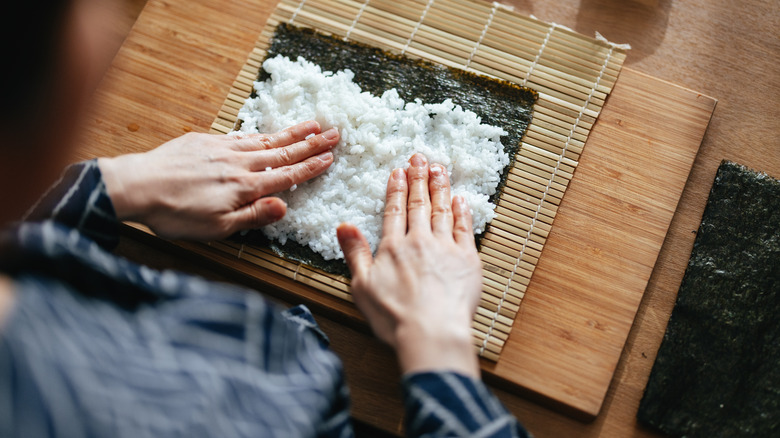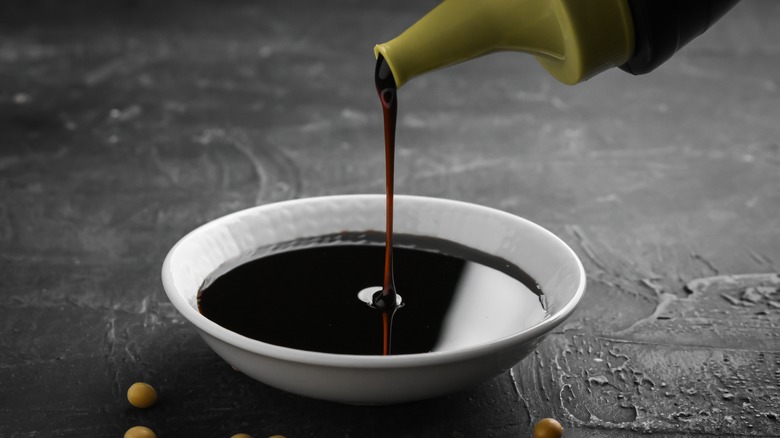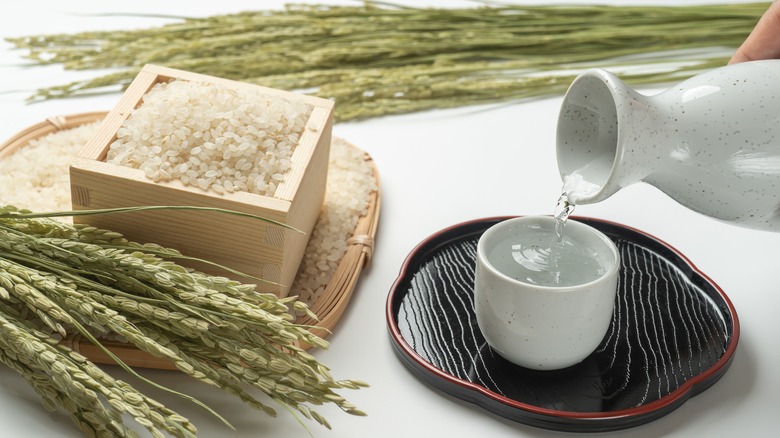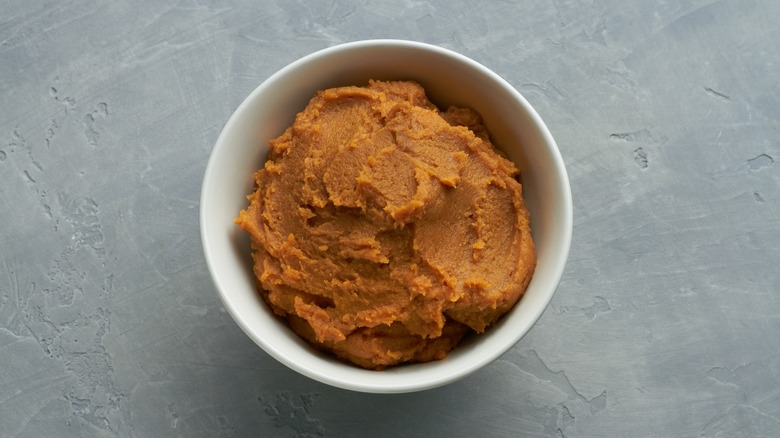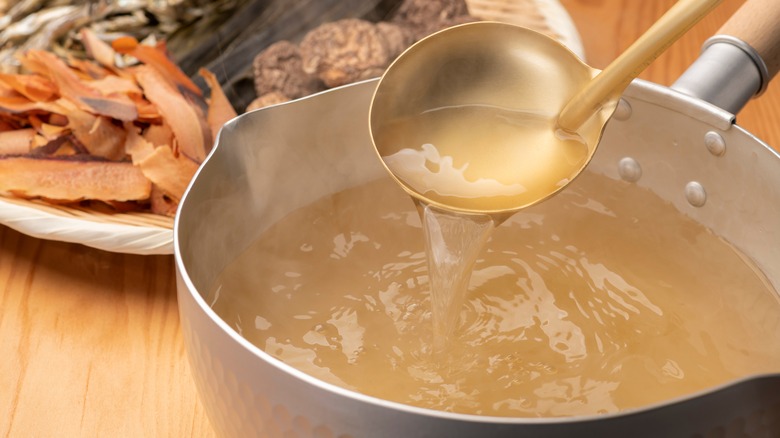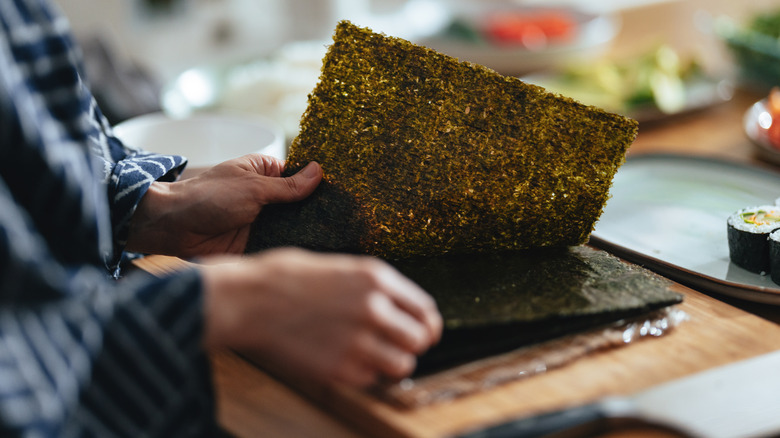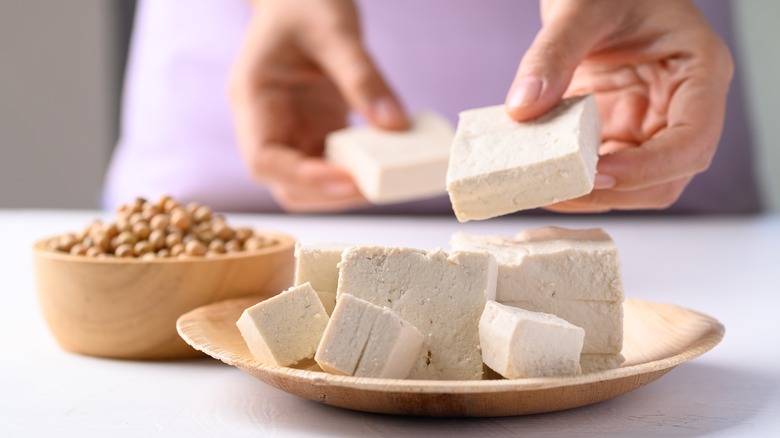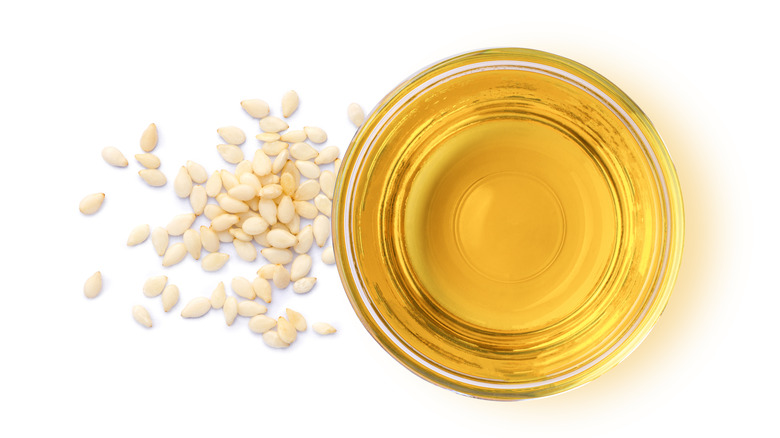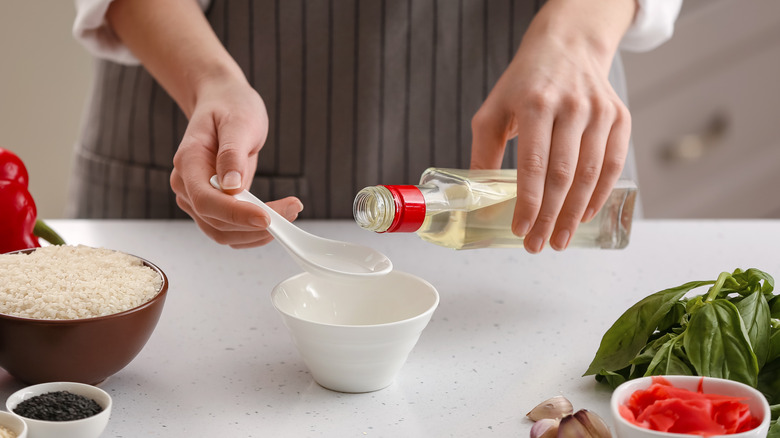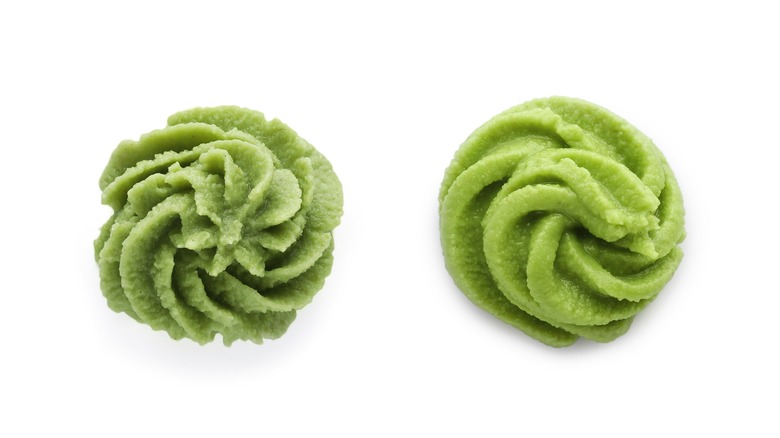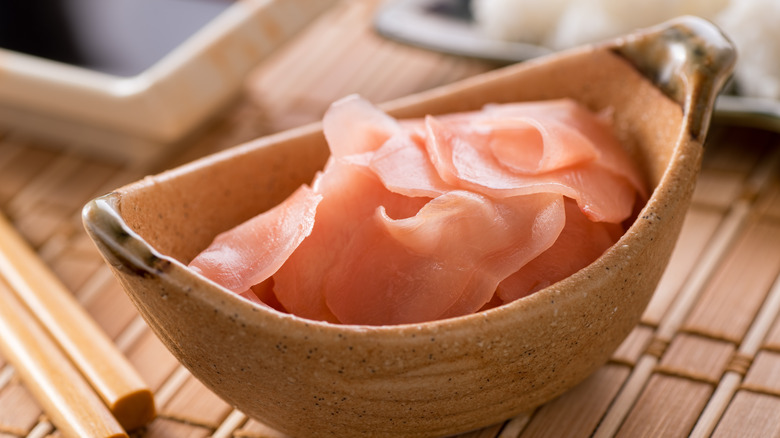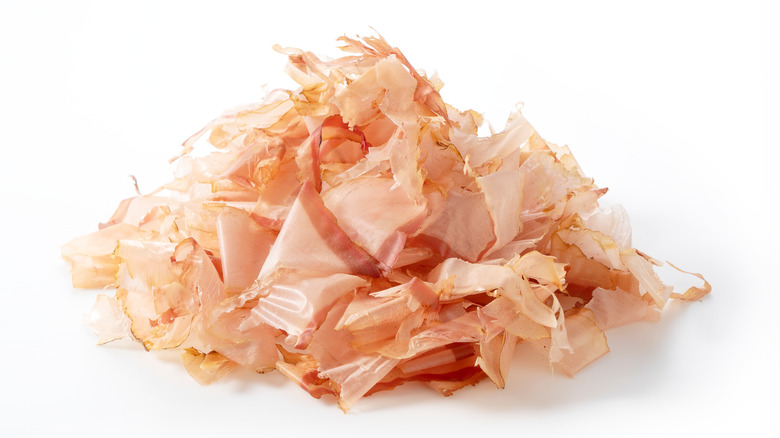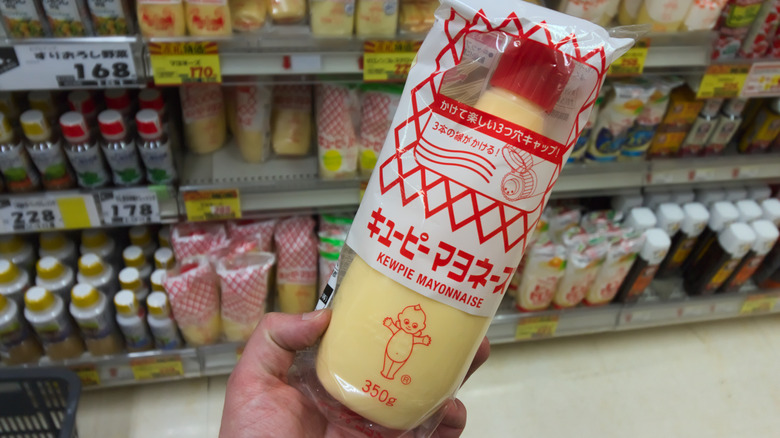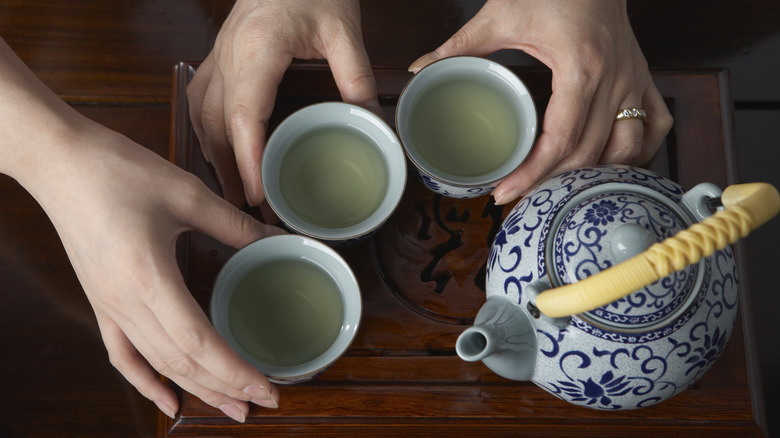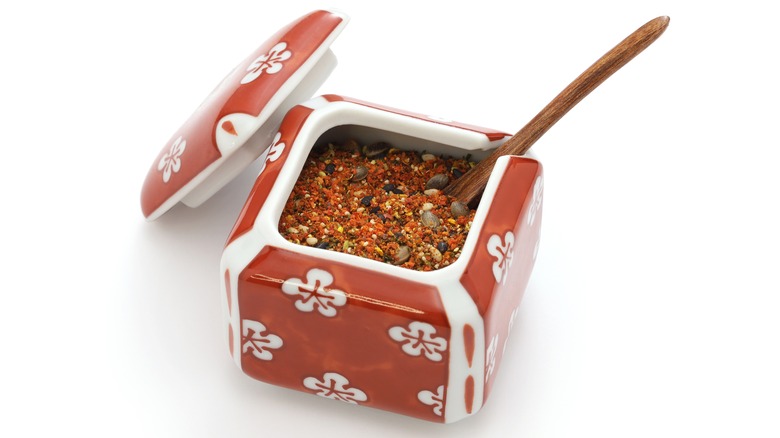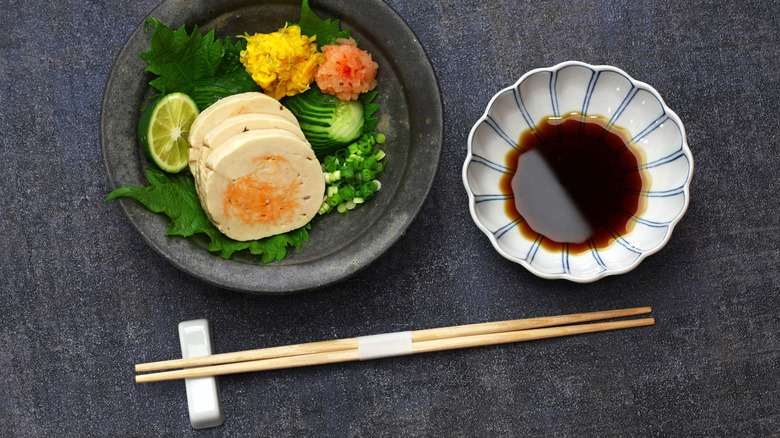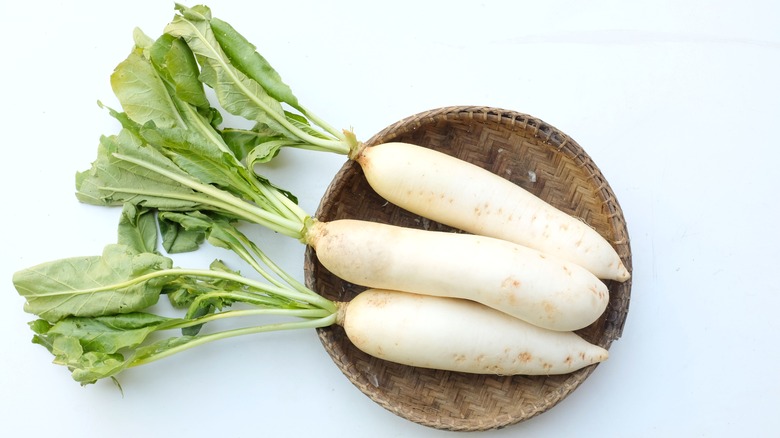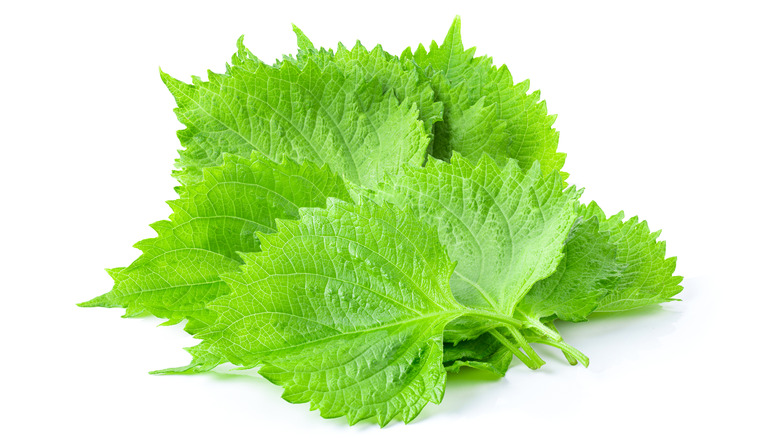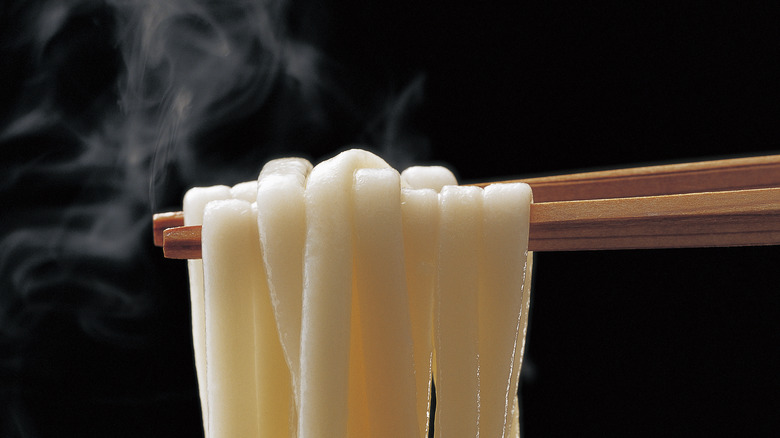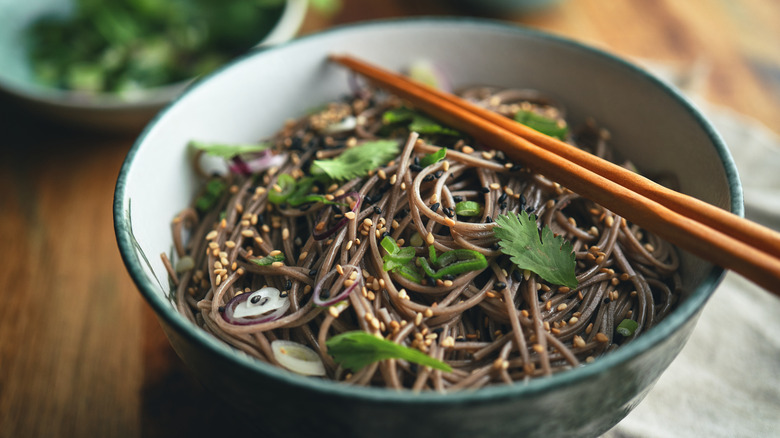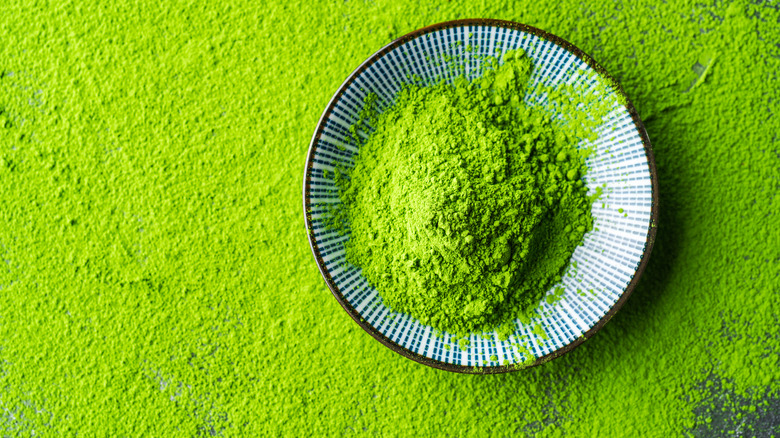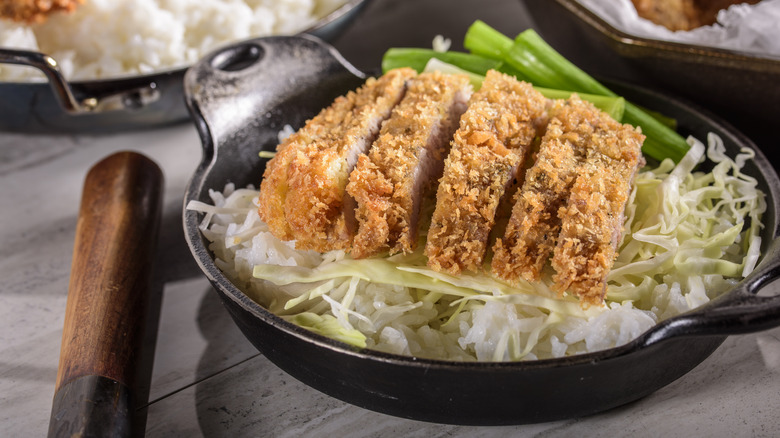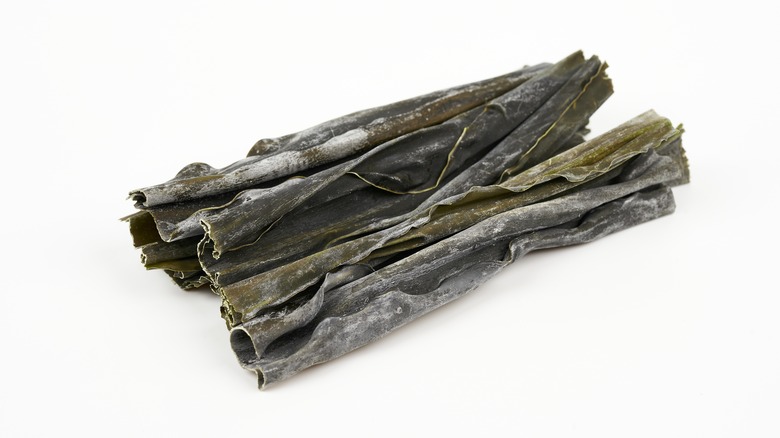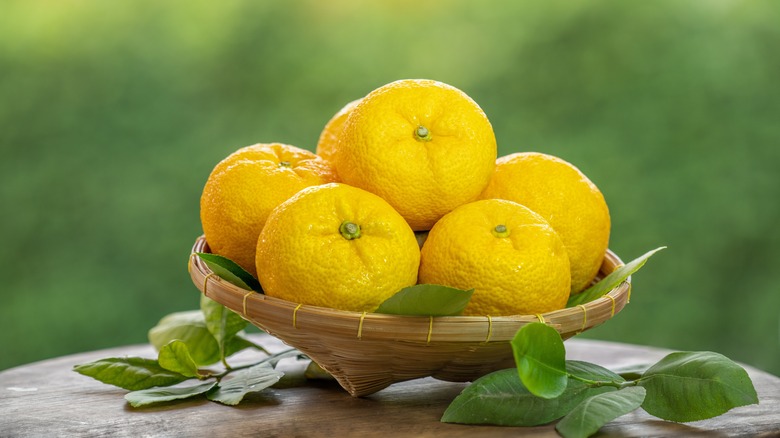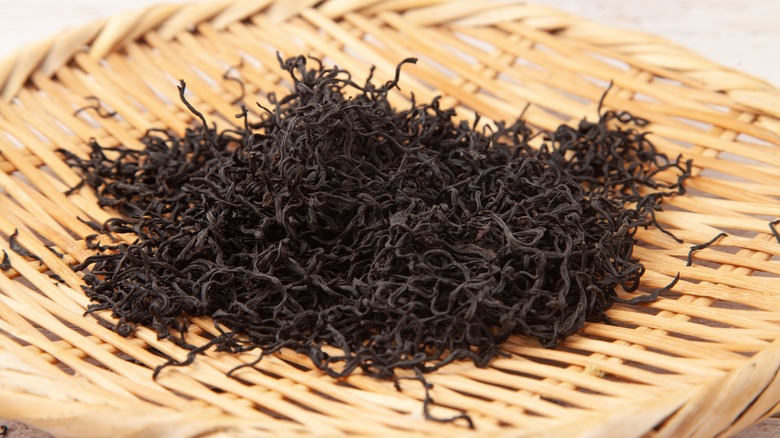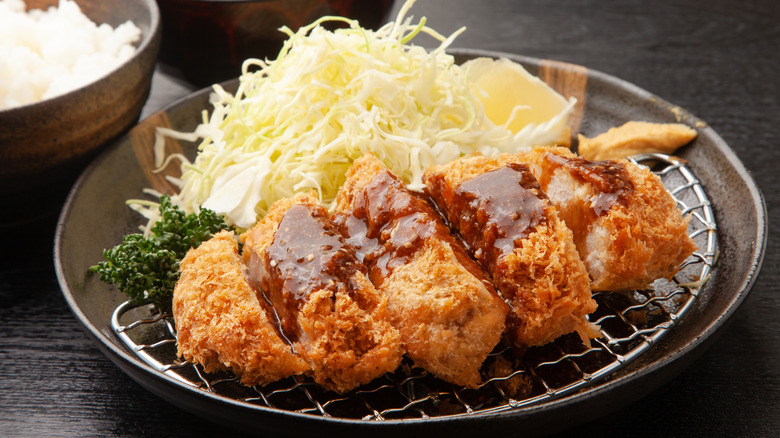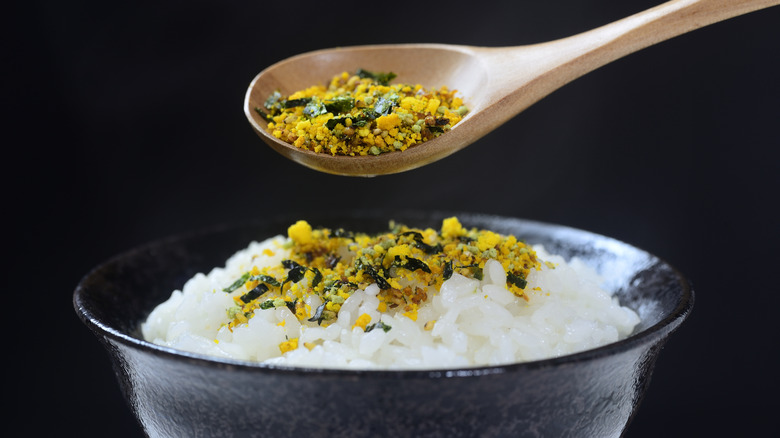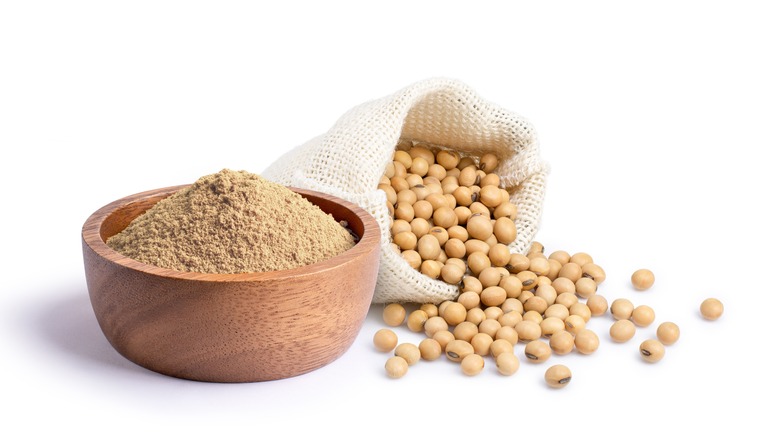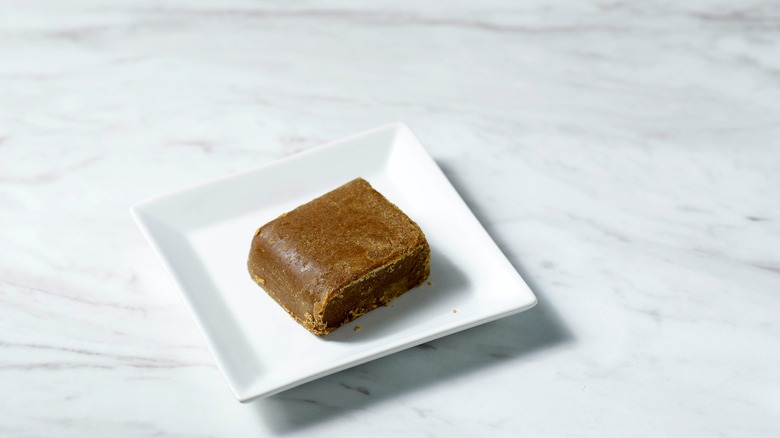30 Essential Ingredients For Japanese Cooking
For centuries, Japan, an island nation, was relatively disconnected from the rest of the world. Although different foods were brought in now and again by the tides of history, this isolation, combined with Japan's unique climate and cultural traditions that date back thousands of years, resulted in a distinct culinary culture that is like no other. Japanese cuisine is celebrated for its seasonal ingredients, delicate flavors, and meticulous preparations.
As early as the 1600s, prints have shown scenes of people congregating in restaurants in urban areas in Japan. Hundreds of years later, Japanese food has become recognized as one of the world's great cuisines, with izakayas, ramen shops, and hibachi steakhouses popping up all over the world.
What makes Japanese food truly unique is the ingredients that are used to make it and how they are employed in the cooking process. Read on to find out more about the ingredients that are truly essential to Japanese cuisine.
Sushi rice
Sushi rice isn't just rice that happens to be used in sushi; it's usually short-grain rice that is higher in starch and proteins than regular rice, which gives it that sticky texture that's perfect for holding your sushi together. There are tons of sushi rice brands to choose from that you can find at a specialty food store and some at your usual supermarket.
But be sure to rinse the rice before you cook it. Rinsing removes the starch from the surface of the rice so that it remains fluffy and doesn't clump together
Soy sauce (shoyu)
Soy sauce, or "shoyu," as it's known in Japan, is perhaps the most ubiquitous Japanese cooking ingredient in the United States. Although there are several types of soy sauce with different flavor profiles, the Japanese version, which is made by fermenting equal parts soybeans and toasted wheat, is far more common in American kitchens.
Shoyu adds saltiness and a slightly sweet, floral, umami flavor to dishes. It's typically used to dip sushi, flavor rice, or make a whole host of shoyu-based sauces and marinades that can bring your Japanese feast up to the next level.
Mirin
Mirin is one of the most important Japanese ingredients you may never have heard of. Made from glutinous (sticky) rice, distilled alcohol, rice fermented with koji (a fungus), and vinegar, mirin has a sweet, umami flavor and is used to season noodles and soups. Traditional mirin has an alcohol content of about 14%, but most mirin sold in the US has only about 1% ABV.
Mirin is also a must in Japanese teriyaki sauce, where it imparts a balance of salty and sweet flavors that give teriyaki its signature tang. Its acidity also makes it perfect for marinades.
Sake
Sake is an alcoholic beverage made from rice that is fermented using koji, a style of fungus that ferments rice and yields alcohol. Although sake has been around for centuries and it's having a moment in the US, where sake bars are popping up in trendy neighborhoods.
But sake isn't just for drinking (although swapping the vermouth with sake for a fresh spin on a martini isn't a bad idea). Adding sake to seafood dishes, sauces, and marinades adds a mellow flavor and can help tenderize meat.
Miso
If you've ever eaten at a Japanese restaurant, chances are you've had miso soup. The fermented soybean paste that gives the soup its signature umami flavor is actually one of the most versatile ingredients in Japanese cooking and can be used for everything from sweets to salad dressing.
There are three types of miso: white, yellow, and red, and each one has a unique application in Japanese cuisine. White miso is the sweetest and lightest, red miso is the funkiest and most robust, and yellow is somewhere in between.
Dashi
Seafood is key to Japanese cuisine. And that doesn't just mean fish and shellfish, but all kinds of sea life, including seaweed. Dashi is a broth made from kombu, a type of dried kelp that is high in glutamate, the amino acid that is primarily responsible for umami flavor.
Dashi is used in a whole range of Japanese dishes but is most commonly consumed in soup. Although Japanese cooking can sometimes be intimidating, homemade dashi makes all the difference for miso soup, and it's surprisingly easy to make if you can get your hands on some kombu.
Nori
We're used to eating vegetables that grow on land, but what about all those leafy greens under the sea? Nori is perhaps the most widely known edible seaweed, and it is usually dried in flat sheets and used to wrap sushi or garnish soup, but it's also delicious as a snack on its own.
In fact, seaweed is the underrated superfood you should be eating more of. Not only does it pack more vitamins and minerals than many land vegetables, but it's high in protein and has a unique flavor profile and a satisfying crunch.
Tofu
If you're looking for a healthy protein to add to a Japanese meal, you need to look no further than tofu. Although the legendary origins of tofu remain a bit opaque, this protein-packed soy bean curd has been around for centuries.
Tofu also contains calcium and vitamin D, which is great for bone health, and it has a subtle, nutty flavor that marries well with many sauces, dips, and marinades. And you don't even have to cook tofu before eating it! Tofu that is sold in stores is already cooked by the time it hits the shelf.
Sesame seeds
If you're looking to level up your Japanese-style stir fry, sesame seeds are an easy, widely available option that can really make it pop. In fact, Japan is the world's biggest consumer of sesame seeds, as they're used in all kinds of dishes, from sushi rolls to sesame-crusted tuna steak. They also pair perfectly with sweet, earthy flavors like the ones found in goma dango, which is red bean paste encased in rice flour and encrusted with sesame seeds.
And sesame seeds aren't just a delicious, aesthetically pleasing garnish. They're loaded with healthy fats, minerals, fiber, and antioxidants.
Rice vinegar
Acidity is a critical component of many dishes. It serves to highlight the flavors or other ingredients while providing a fresh, tangy contrast to fats and balancing out bitterness and sweetness.
Japanese cooking relies heavily on rice vinegar to add that acidic splash that balances out so many dishes, dressings, and sauces. The two types of Japanese rice vinegar are white rice vinegar, which is more common and versatile, and brown rice vinegar, which is darker, has a richer, more umami taste, and is often used in dipping sauces for meat and fish.
Wasabi
If you've eaten wasabi, it's not an experience you'll soon forget. This bright green paste is often mixed with soy sauce and served alongside sushi and gives a hot, sinus-clearing blast of flavor to anything its eaten with.
Wasabi is made from a rhizome, Wasabia japonica, a finicky plant that mostly grows in certain regions of Japan. Since it is difficult and expensive to cultivate, real wasabi is incredibly difficult to find. 99% of wasabi sold in the United States is an imitation made from horseradish, and even in its native Japan, 95% sold is the fake stuff!
Pickled ginger
If you've eaten sushi at a Japanese restaurant, you're probably familiar with the little pile of pink pickled ginger served alongside your roll or sashimi. Restaurants pair sushi with ginger to serve as a palate-cleansing bite in between different types of fish so that the different tastes don't intermingle and you can appreciate each one separately.
And pickled ginger isn't just for sushi. You can chop up pickled ginger and use it in a stir-fry, and it's also served alongside Japanese curry and as a garnish on top of other Japanese favorites like oyako donburi.
Bonito flakes
Bonito flakes are a feast for the senses. Their look is unforgettable; they're light and often look like they're dancing on top of hot dishes. The flakes are made of cured skipjack tuna sliced into ultra-thin slices. The flakes are high in inosinate, a compound known for its umami flavor profile.
Bonito flakes are an ingredient in so many Japanese dishes, like okonomiyaki (a type of vegetable pancake) and omusoba (a noodle-stuffed omelet), where they're used as a garnish. They're also great for flavoring broths because they dissolve quickly and add a salty, fishy flavor.
Japanese mayo
Japanese mayo, often called Kewpie mayo after the most popular brand of the condiment in Japan, isn't the mayonnaise you're used to. Although they're both oily, eggy concoctions that can enhance dishes, there are some differences between Kewpie mayo and regular mayo.
For starters, the Japanese version uses only egg yolks, which makes it smoother and creamier, incorporates a blend of vinegars to cut through the yolky fattiness, and MSG is added to give the mayo a distinctly savory flavor. The signature squeeze bottle makes it all too easy to level up your Japanese dishes with this delicious topping.
Green tea
Green tea is ubiquitous in restaurants in Japan. Not only is it packed with antioxidants, but it may help you improve brain function, lose weight, and even lower the risk of some types of cancer. But green tea isn't just used as a drink.
Some Japanese dishes incorporate tea leaves as a flavoring. Ochazuke, the soothing Japanese tea-over-rice dish perfect for leftover tuna, is a great example of how tea is used to add a complex flavor profile to a dish. It might sound surprising to use green tea in a savory dish, but it's worth a try!
Shichimi togarashi
Teriyaki is one Japanese dish that has certainly made its way into mainstream American restaurants. The signature sweet and savory sauce has been around for hundreds of years in Japan, and there's a key spice blend for bold and flavorful teriyaki that has been instrumental to its popularity: shichimi togarashi.
Also known as Japanese seven spice mix, shichimi togarashi is usually made from the following seven ingredients: "red chili pepper, sansho pepper, hemp seeds and/or poppy seeds, white sesame seeds and/or black sesame seeds, ground ginger, yuzu or mandarin orange peel, and nori" (per Masterclass).
Ponzu sauce
There's nothing like a Japanese gyoza (a savory dumpling filled with meat or veggies). But if you're looking for a dip to make your gyoza even better, you've got to get your hands on some ponzu sauce.
Ponzu sauce has a characteristic citrusy, acidic tang that combines some of the best of Japan's flavors in one humble dip: soy sauce, seaweed, bonito flakes, mirin, citrus, and rice vinegar. This winning combo can be used in dressings, sauces, and marinades to give them a sharp, umami edge.
Daikon radish
Daikon is a type of radish that is long and white and has a slightly spicy flavor, similar to a red radish but is milder, and the flavor changes along the length of the radish. The end near the greens is a bit sweeter, and the opposite end is spicier.
Daikon is so popular in Japan because it is available year-round and it can easily take on different flavors, making it ideal for pickling, grilling, and adding to sauces and salads. Daikon is also high in vitamins and minerals and is often grated raw to adorn dishes.
Shiso leaves
If you're familiar with shiso leaves, it's probably because you've seen them as a garnish on your sushi plate alongside ginger and wasabi. These bright green leaves have a serrated edge and belong to the mint family, so sometimes they're known as Japanese mint.
But shiso leaves are more than just a pretty decoration on your sushi platter. Although they're usually eaten raw and have a strong minty taste with undertones of basil and cloves, they're also used in other applications like salads, sweets and even fried in tempura batter.
Udon noodles
There are no noodles more slurpable than udon. Udon noodles are typically thick and round like massive spaghetti noodles, and they're made from just three ingredients: water, salt, and wheat flour. They're super chewy and usually enjoyed in a hot broth, but they also make a great stir-fry base.
Since they're so simple, they easily take on the flavors around them, which makes them very versatile. You can have them smothered in curry sauce or try your hand at making hiyashi yamakake, a traditional Japanese noodle dish that features mountain yam.
Soba noodles
Soba is a noodle with a personality. These thin noodles are made from buckwheat, which has a higher protein and fiber content than wheat and gives them a distinct nutty flavor that goes well with a wide variety of broths and sauces.
And you should slurp soba noodles, not chew them. Though it's frowned upon in the West, slurping is an indicator of enjoyment in Japan, and it also cools the noodles down as you eat them so that you can taste them at peak freshness after they're cooked.
Matcha
Matcha is all the rage these days. The finely ground green tea powder has a unique grassy taste, and it's often whisked with hot water and enjoyed as a beverage. But there are also unexpected ways to use matcha out there that you may not be aware of.
When it's used in food, matcha is most often paired with sweet dishes. You can put matcha powder in pancakes, waffles, muffins, and even popsicles. On the savory side, you can use it in salad dressings, hummus, or whatever you think would benefit from this unique ingredient.
Panko breadcrumbs
If you've done much Italian cooking, you're probably familiar with breadcrumbs, but perhaps you've never cooked with panko breadcrumbs. The difference between panko and regular breadcrumbs is that the latter is made with super dry bread that is shaved rather than pulsed in a food processor.
This results in breadcrumbs that absorb very little oil when fried compared to traditional breadcrumbs, so that they remain crispier when they come out of the pan or the frier. While panko is traditionally used in Japanese cooking, you can substitute it in place of regular breadcrumbs for an added crunch.
Kombu
Maybe your mouth doesn't water when you think about eating kelp, but maybe you just haven't been introduced in the right way. Kombu is the seaweed umami staple you should have in your pantry because it is very versatile and adds a unique depth of flavor.
Kombu is harvested in northern Japan, where it is processed and dried out before it hits the shelves in the supermarket. Kombu is high in glutamate, an amino acid responsible for the meaty, umami taste that kombu imparts to a broth when it is added.
Yuzu
Citrus fruits add an acidic bite and a strong aroma to dishes and are useful for balancing out other flavors. Yuzu, a citrus that's common in Japan, is often used for just that purpose.
Yuzu fruit is important in Japanese cuisine and is used in desserts like cakes, ice creams, and custards because its tartness contrasts nicely with sugar. Yuzu can also be added to the broth hot pot with vegetables and tofu for a unique twist on a savory main course. It's even used in the water in some public baths in Japan because of its health benefits.
Hijiki
There are so many types of sea vegetables that are edible, but we don't eat most of them. In Japan, sea vegetables have been part of the national cuisine for centuries, and hijiki, a brown seaweed that grows on rocky coastlines, is a favorite in the country.
Hijiki is typically sold dried and can be rehydrated and ready to cook by placing it in a bowl of cold water for thirty minutes. It has an earthy taste and is often mixed with other vegetables, seasoned, and eaten as a salad.
Japanese Worcestershire
If you're a fan of meat, you've probably heard of Worcestershire sauce. You may not know, however, that this salty, smoky, vinegary sauce has a Japanese cousin. Like its British cousin, Japanese Worcestershire sauce is all about that umami flavor, but it is a bit sweeter and less acidic.
Japanese Worcestershire is made of a combination of fruits, vegetables, and spices. It's a key ingredient used in several condiments that are common in Japanese cuisine like tonkatsu sauce, which is used for pork cutlet and okonomiyaki, a savory pancake with cabbage, meat, and seafood.
Nori furikake
Furikake seasoning has been around for over a thousand years, so you know it's at least got staying power. The combination of dried fish flakes, nori seaweed, and sesame seeds can also sometimes come in variations that include yuzu peel, shiitake mushroom powder, or wasabi.
In Japanese cuisine, it is typically used on onigiri (rice balls), fish, and rice, but you can use furikake on just about anything. It's great as a seasoning on ramen, eggs or miso soup, and it will also elevate your roasted vegetables to new heights with its powerful umami flavor.
Kinako
Japanese cuisine is much more than just savory dishes like sushi, noodles, and tempura. Japan also has a rich and decadent dessert culture, and kinako, a roasted soybean flour, is one unique ingredient that sets Japanese desserts apart from the rest.
Kinako is a fine powder with a nutty flavor that's a bit sweet and reminiscent of roasted peanuts. It's often sprinkled on top of mochi, a chewy dessert made of glutinous rice flour, along with some sugar to sweeten it up a bit, but you can also use kinako on yogurt or ice cream for a little nutty flair.
Curry cubes
Making curry can seem like an intimidating task. But if you're making Japanese curry, you're in luck: There's a shortcut. Japanese curry cubes, which are made of curry roux that is set in little squares, are packed with all of the concentrated flavor that makes Japanese curry delicious.
These little miracles have been around since the 1950s and have saved cooks in Japan and around the world countless hours of kitchen labor. You can buy them at most Asian specialty grocery stores, and they're super easy to use. Cook them with meat and vegetables and serve over rice.

